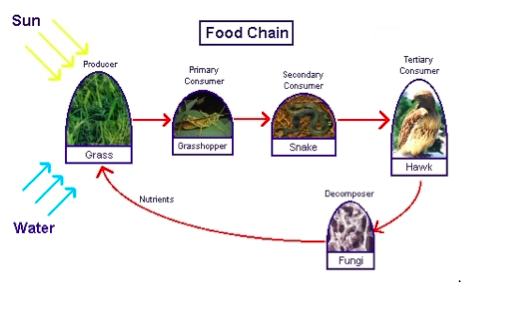Draw A Food Web Worksheet
Organisms living in an ecosystem are all connected and intertwined. Some organisms work together, with shared benefits (like honey bees aiding pollination of some flowers). More common, organisms rely on each other as a food source. A food chain shows how each living thing gets its food. Some animals eat plants and some animals eat other animals. For example, a simple food chain links the shrubs, the rabbits that eat shrubs, and the bears that eat the rabbits. Each link in this chain is food for the next link. All food chains start with energy from the sun. This energy is captured by plants. Thus the living part of a food chain always starts with plant life and ends with an animal.

Plants are called producers because they are able to use light energy from the sun to produce food (sugar) from carbon dioxide and water. Animals cannot make their own food, so they must eat plants and/or other animals. They are called consumers. There are three groups of consumers: primary, secondary, and tertiary. Animals that eat ONLY PLANTS are called herbivores and are primary consumers. Animals that eat OTHER ANIMALS are called carnivores. Carnivores that eat herbivores are called secondary consumers, and carnivores that eat other carnivores are calledtertiary consumers. Animals—including people—that eat BOTH animals and plants are called omnivores. Then there are decomposers (bacteria, fungi, and even some worms), which feed on decaying matter. These decomposers speed up the decaying process, which releases mineral salts backinto the food chain for absorption by plants as nutrients.
In a food chain, energy is passed from one link to another. When a herbivore eats, only a fraction of the energy that it gets from the plant food becomes new body mass; the rest of the energy is lost as waste or used up by the herbivore to carry out its life processes (i.e., movement, digestion, reproduction). Therefore, when the herbivore is eaten by a carnivore, it passes only a small amount of the total energy it has received to the carnivore. Of the energy transferred from the herbivore to the carnivore, some energy will be "wasted" or "used up" by the carnivore. So the carnivore has to eat many herbivores to get enough energy to grow. Because of the large amount of energy that is lost at each link in the food chain, the amount of energy that is transferred up the chain gets less and less. The higher up the food chain you go, the less food—and hence energy—remains available.
Food chains can be represented as a pyramid.

The above energy pyramid shows many trees and shrubs providing food and energy to giraffes. As we go up the food chain, there are fewer giraffes than trees and shrubs and a lot fewer lions than giraffes. This shows that as we go higher up a food chain, there are fewer and fewer consumers. In other words, a large mass of living things at the base of a food chain is required to support a few at the top. Many herbivores are needed to support a few carnivores. Most food chains have no more than four or five links. There cannot be too many links in a single food chain because the animals at the end (top) of the chain would not get enough food—and hence energy—to stay alive.
Food chains can get complicated because animals usually eat a variety of food. Most animals are part of more than one food chain and eat more than one kind of food in order to meet their food and energy requirements. When many food chains weave together, they create a food web.
Draw A Food Web Worksheet
Source: https://www.mpalalive.org/classroom/lesson/food-chains-us
Posted by: damianoupinedegs.blogspot.com

0 Response to "Draw A Food Web Worksheet"
Post a Comment